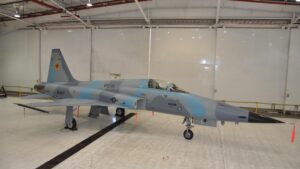The Navy and Marine Corps said they are replacing a potentially defective part used in pilot ejection in some planes like Super Hornets and training aircraft and grounding some planes as part of the process.
The Navy was notified of a potential defect on the cartridge actuated devices (CAD) in some fixed-wing aircraft by the vendor, Martin Baker
. The service said it used “validated radiography procedures” to scan on-hand inventory to verify replacement CAD parts were made correctly before starting to send them out to the fleet.
The service said the CADs specifically “initiate a series of automatic functions when aircrew pull the ejection handle to safely egress the aircraft and deploy the aircrews’ parachute.”
Navy Air Systems Command (NAVAIR) spokeswoman Marcia Hart told Defense Daily that the CAD issue was discovered by the vendor after removal of an injection seat during routine maintenance.
The CAD is regularly inspected and replaced if needed during aircraft period maintenance and can be affected by environmental and operational conditions.
“The Navy and Marine Corps are collaborating to quickly resolve the issue. The safety of Sailors and Marines is the top priority,” the service said in a statement.
Hart confirmed that NAVAIR also made the decision to “ground some fixed-wing aircraft” due to the CAD issue.
“All affected CADs will be replaced to enable aircraft to return to full mission capable status before next flight,” Hart said in a statement.

The Navy emphasized that only CAD-equipped aircraft within a “limited range of lot numbers” are affected, but this includes the Boeing [BA] F/A-18B/C/D Hornets and F/A-18E/F Super Hornets, EA-18G Growlers, T-45 Goshawks and Northrop Grumman [NOC] F-5 Tiger II trainers.
Affected aircraft are identified by tail number and their CADs are now due to be replaced at the aircraft’s assigned squadron whereupon the aircraft will be inspected before its next flight.
While NAVAIR did not say how long the replacement process will take overall, Hart said it takes several hours to install and ready the replacement part per aircraft.
“Prior to next flight, organizational level maintainers will replace CADs on all affected aircraft. The required bulletin compliance — the set of set of instructions for inspection and what actions should be taken — will take organizational level maintainers approximately four to eight man-hours to complete,” Hart said.
The CADs are being sent out to the fleet via prioritized delivery to aviation squadrons using express carriers.
CADs and Propellant Actuated Devices (PADs) for the Navy, Marine Corps, Army and Air Force are all provided by the Naval Surface Warfare Center Indian Head Division (NSWC IHD).
NSWC IHD started shipping cleared replacement parts on July 24 to fleet maintenance centers and planned to continue shipments throughout this week.
Commander, Naval Air Forces, U.S. Pacific Fleet (CNAP); Commander, Naval Air Force Atlantic (CNAL); and USMC Supply and Maintenance centers are all coordinating the prioritized delivery of the devices to aviation squadrons.
Hart confirmed that NAVAIR is also working with all Foreign Military Sales partners affected by the CAD issue as well.